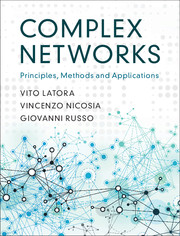Book contents
- Frontmatter
- Dedication
- Contents
- Preface
- Introduction
- Epigraph
- 1 Graphs and Graph Theory
- 2 Centrality Measures
- 3 Random Graphs
- 4 Small-World Networks
- 5 Generalised Random Graphs
- 6 Models of Growing Graphs
- 7 Degree Correlations
- 8 Cycles and Motifs
- 9 Community Structure
- 10 Weighted Networks
- Appendices
- References
- Author Index
- Index
10 - Weighted Networks
Published online by Cambridge University Press: 11 October 2017
- Frontmatter
- Dedication
- Contents
- Preface
- Introduction
- Epigraph
- 1 Graphs and Graph Theory
- 2 Centrality Measures
- 3 Random Graphs
- 4 Small-World Networks
- 5 Generalised Random Graphs
- 6 Models of Growing Graphs
- 7 Degree Correlations
- 8 Cycles and Motifs
- 9 Community Structure
- 10 Weighted Networks
- Appendices
- References
- Author Index
- Index
Summary
In the networks studied in the previous chapters, for each pair of nodes we can either have a link or not. In actual fact, real networks can display a large variety in the strength of their connections. Examples are the existence of strong and weak ties between individuals in any type of social system, or unequal capacities in infrastructure networks such as the Internet or a transportation system. When we have access to information about the intensity of interactions in a complex system, the structure of such a system can certainly be better described in terms of a weighted network, i.e. a network in which each link is associated with a numerical value, in general a positive real number, representing the strength of the corresponding connection. In this chapter, we extend and generalise to weighted networks the concepts and methods we have introduced in the previous chapters of the book. We will start introducing some basic measures to characterise and classify a weighted network. Next, we will discuss how to perform a motif analysis and how to detect community structures in weighted networks. The results of our empirical studies will demonstrate that purely topological models are often inadequate to explain the rich and complex properties observed in real systems, and that there is also a need for models to go beyond pure topology. We will then introduce some models of weighted networks which can reproduce the broad scale distributions and the correlations between topology and weights found empirically. Finally, as an application, we will show what we can learn about financial systems by describing correlations among stocks in a financial market in terms of a weighted network.
Tuning the Interactions
There are plenty of cases where (unweighted) graphs are a poor representation of realworld networks. As a concrete example, let us come back to the scientific collaboration networks studied in Chapter 3. When we constructed such graphs in Section 3.5 we linked pairs of scientists who have coauthored at least one paper. However, it is clear that scientists who have written many papers together are expected to know each other better than those who have coauthored only one paper.
- Type
- Chapter
- Information
- Complex NetworksPrinciples, Methods and Applications, pp. 374 - 409Publisher: Cambridge University PressPrint publication year: 2017



